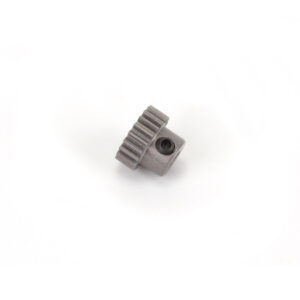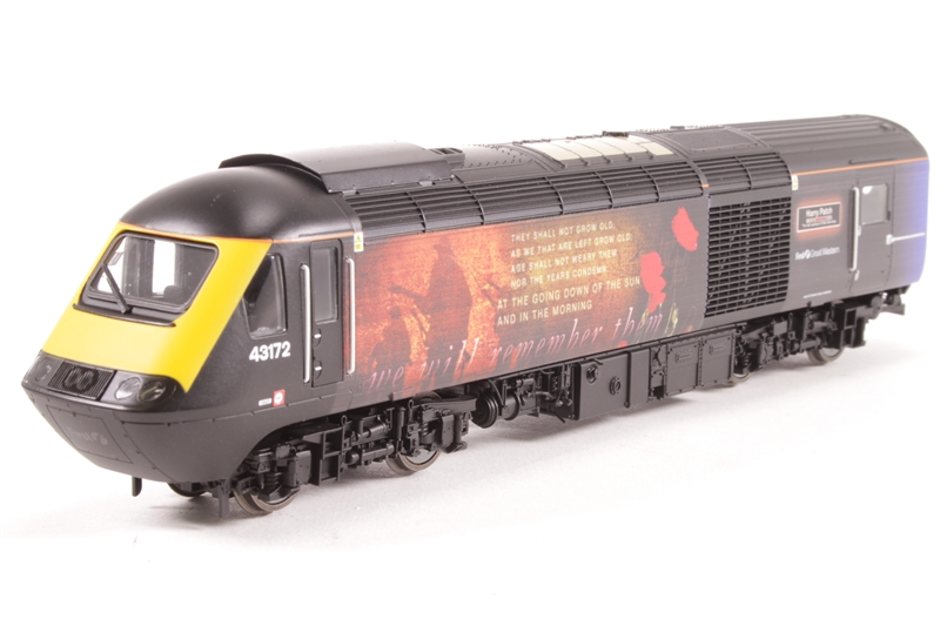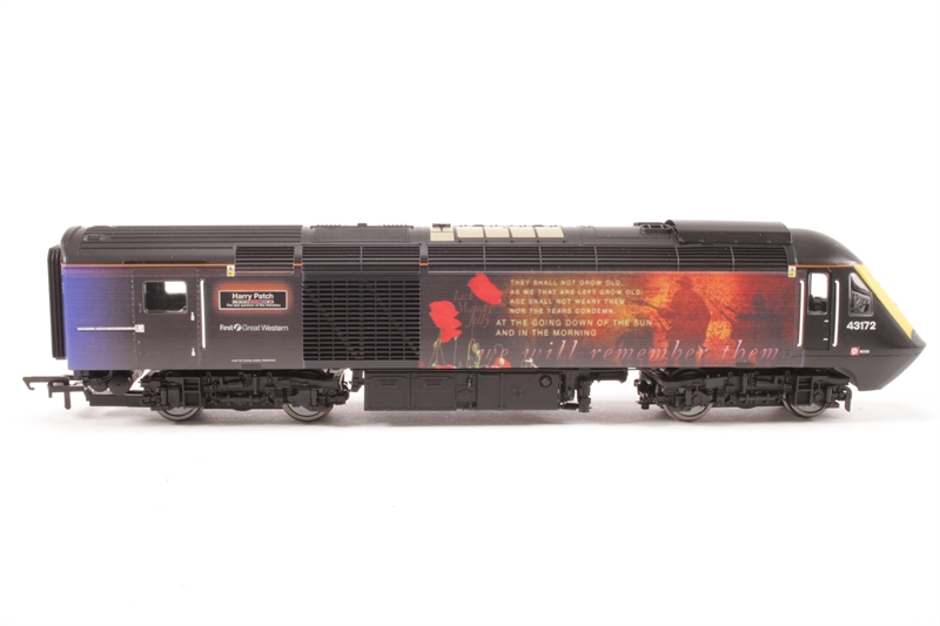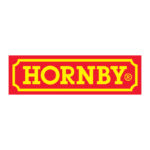You are here:
Hornby R3379 First Great Western (FGW) New Limited Edition HST Train Pack Harry Patch DCC Ready. Pre-owned.
Hornby R3379 First Great Western (FGW) New Limited Edition HST Train Pack Harry Patch. Pre-owned.
Out of stock
Description
Hornby R3379 First Great Western (FGW) New Limited Edition HST Train Pack Harry Patch Pre-owned..
Hornby R3379 Class 43 HST 125 FGW in Special Harry Patch Livery. NRM Limited Edition of 500. Tested and displayed only like new. Pre-owned.
Biography
Harry Patch was born in the village of Combe Down, near Bath, Somerset, England. He appears in the 1901 Census as a two-year-old boy along with his stonemason father William John Patch (1863-1945), mother Elizabeth Ann (née Morris) (1857-1951) and older brothers George Frederick (1888-1983) and William Thomas (1894-1981) at a house called “Fonthill”. The family are recorded at the same address “Fonthill Cottage” in the 1911 census. His elder brothers are recorded as a carpenter and banker mason. Longevity ran in Patch’s family; his father lived to 82, his mother to 94, his brother George to 95 and his brother William to 87. Patch left school in 1913 and became an apprentice plumber in Bath.
In October 1916, during World War I, he was conscripted into the British Army as a private, reporting for duty at Tolland Barracks, Taunton. During the winter of 1916-17 he was promoted lance-corporal but was demoted after a fist fight with a soldier, who had taken Patch’s boots from his billet, and he saw no further promotion. Patch went through a series of short-lived attachments to several regiments, including the Royal Warwickshire Regiment before being posted after completing training to the 7th (Service) Battalion, Duke of Cornwall’s Light Infantry, serving as an assistant gunner in a Lewis gun section. Patch arrived in France in June 1917. He fought on the Western Front at the Battle of Passchendaele (also known as the Third Battle of Ypres) and was injured in the groin, when a shell exploded overhead at 22:30 on 22 September 1917, killing three of his comrades. He was removed from the front line and returned to England on 23 December 1917. Patch referred to 22 September as his personal Remembrance Day. He was still convalescing on the Isle of Wight when the Armistice with Germany was declared the following November.
When the war ended, I don’t know if I was more relieved that we’d won or that I didn’t have to go back. Passchendaele was a disastrous battle thousands and thousands of young lives were lost. It makes me angry. Earlier this year, I went back to Ypres to shake the hand of Charles Kuentz, Germany’s only surviving veteran from the war. It was emotional. He is 107. We’ve had 87 years to think what war is. To me, it’s a licence to go out and murder. Why should the British government call me up and take me out to a battlefield to shoot a man I never knew, whose language I couldn’t speak? All those lives lost for a war finished over a table. Now what is the sense in that?
Harry Patch
After the war, Patch returned to work as a plumber, during which time he spent four years working on the Wills Memorial Building in Bristol, before becoming manager of the plumbing company’s branch in Bristol. A year above the age to be called up for military service at the outbreak of the Second World War in 1939, he became a part-time fireman in Bath, dealing with the Baedeker raids. Later in the war he moved to Street, Somerset, where he ran a plumbing company until his retirement at the age of 65.
Patch married Ada Emily Billington (1891-1976) at the Parish Church, Hadley, Shropshire on 13 September 1919. Harry and Ada had two children. Denis Howard Patch (1920-1987) and Gorden Roy Patch (1927-2002). Ada suffered a severe stroke in 1976 and died at Wells and District Hospital on 20 September 1976, aged 85.
Harry married Kathleen Alice Joy (née Weedon) (1901-1989) at Mendip Register Office on 5 June 1982. Harry was 83 and Kathleen, known as Jean, was 80. Jean died of breast cancer at St Margaret’s Hospice, aged 87 on 18 March 1989.
Harry’s elder son, Denis, was deeply affected by his mother’s death and began drinking heavily. Denis died at Kings College Hospital, London, in 1987 of cirrhosis of the liver, aged 66.
At the age of 100, Harry moved to Fletcher House Nursing Home. Harry found a companion in widow Doris Whitaker (1914-2007).
Harry became estranged from his son Gorden, known as Roy, following Denis’s death and they did not speak for the last twenty years of Roy’s life. Roy died of cancer in 2002 aged 75.
Harry’s partner Doris died on 19 March 2007 aged 92.
The Last Tommy
Patch had refused to discuss his war experiences, until approached in 1998 for the BBC One documentary Veterans, on reflection of which and with the realisation that he was part of a fast dwindling group of veterans of “the war to end all wars”, he agreed.
Patch was featured in the 2003 television series World War 1 in Colour and said, “if any man tells you he went over the top and he wasn’t scared, he’s a damn liar”. He reflected on his lost friends and the moment when he came face to face with a German soldier. He recalled the story of Moses descending from Mount Sinai with God’s Ten Commandments, including “Thou shalt not kill” and could not bring himself to kill the German. Instead, he shot him in the shoulder, which made the soldier drop his rifle. However, he had to carry on running towards his Lewis Gun, so to proceed, he shot him above the knee and in the ankle. Patch said,
I had about five seconds to make the decision. I brought him down, but I didn’t kill him? Any one of them could have been me. Millions of men came to fight in this war, and I find it incredible that I am the only one left.
Commenting on graves at a Flanders war cemetery, July 2007.
In November 2004, at the age of 106, Patch met Charles Kuentz, a 107-year-old Alsatian veteran, who had fought on the German side at Passchendaele (and served on the French side in World War II). Patch was quoted as saying: “I was a bit doubtful before meeting a German soldier. Herr Kuentz is a very nice gentleman, however. He is all for a united Europe and peace – and so am I”. Kuentz had brought along a tin of Alsatian biscuits and Patch gave him a bottle of Somerset cider in return. The meeting was featured in a 2005 BBC TV programme The Last Tommy, which told the stories of several of Britain’s last World War I veterans.
In December 2004, Patch was given a present of 106 bottles of Patch’s Pride Cider, which has been named after him and produced by the Gaymer Cider Company. In the spring of 2005, he was interviewed by the Today programme, in which he said of the First World War: “Too many died. War isn’t worth one life” and in July 2005, Patch voiced his outrage over plans to build a motorway in northern France over cemeteries of the First World War.
In July 2007, marking the 90th anniversary of the beginning of the Battle of Passchendaele, Patch revisited the site of the battle in Flanders, to pay his respects to the fallen on both sides. He was accompanied by a historian, Richard van Emden. On this occasion, Patch described war as the “calculated and condoned slaughter of human beings” and said that “war isn’t worth one life”.
In August 2007, Patch’s autobiography The Last Fighting Tommy was published, making him one of the oldest authors ever. With the proceeds from this book, Patch decided to fund an Inshore Lifeboat for the Royal National Lifeboat Institution (RNLI) and he attended the RNLI’s Lifeboat College on 20 July 2007, to officially name the boat The Doris and Harry.
In February 2008, the poet laureate of the United Kingdom, Andrew Motion, was commissioned by the BBC West television programme Inside Out West, to write a poem in Patch’s honour. Entitled “The Five Acts of Harry Patch” it was first read at a special event at the Bishop’s Palace in Wells, where it was introduced by the Prince of Wales and received by Harry Patch.
In July 2008, Wells City Council conferred the freedom of the city of Wells on Patch. On 27 September 2008, in a private ceremony attended by a few people, Patch opened a memorial on the bank of the Steenbeek, at the point where he crossed the river in 1917. The memorial reads,
Here, at dawn, on 16 August 1917, the 7th Battalion, Duke of Cornwall’s Light Infantry, 20th (Light) Division, crossed the Steenbeek prior to their successful assault on the village on Langemarck. This stone is erected to the memory of fallen comrades, and to honour the courage, sacrifice and passing of the Great War generation. It is the gift of former Private and Lewis Gunner Harry Patch, No. 29295, C Company, 7th DCLI, the last surviving veteran to have served in the trenches of the Western Front.”
In October 2008, Patch launched the 2008 Royal British Legion Poppy Appeal in Somerset. On 11 November 2008, marking the 90th anniversary of the end of World War I, together with fellow veterans Henry Allingham and Bill Stone, Patch laid a commemorative wreath for the Act of Remembrance at The Cenotaph in London, escorted by Victoria Cross recipient Johnson Beharry.
On 9 November 2008, the Master of the Queen’s Music, Sir Peter Maxwell Davies, attended the world premiere of his choral work paying tribute to Patch. The piece sets words by the Poet Laureate, Andrew Motion, and was performed at Portsmouth Cathedral by the London Mozart Players, the Portsmouth Grammar School chamber choir and the cathedral’s choristers. The creation of the work was featured in A poem for Harry, a BBC West documentary that was subsequently repeated on BBC Four. The programme won a gold medal at the New York Festivals International Television Programming and Promotion Awards.
On 18 July 2009, with the death of Henry Allingham, Patch became the oldest surviving veteran and also the oldest man in the United Kingdom. Patch was the last trench veteran of World War I. The penultimate Western Front veteran, the 108-year-old Fernand Goux of France, who died on 9 November 2008, fought for 8 days. He came out unscathed, unlike Patch and the last Alpine Front veteran, 110-year-old Delfino Borroni of Italy, who died on 26 October 2008. Patch was also the last surviving Tommy, since the death on 4 April 2009 of Netherwood Hughes, who was still in training when the war ended. The last-but-one fighting Tommy, Harold Lawton, died on 24 December 2005. Claude Choules, the last remaining First World War naval veteran, died on 5 May 2011.
We came across a lad from A company. He was ripped open from his shoulder to his waist by shrapnel and lying in a pool of blood. When we got to him, he said: ‘Shoot me’. He was beyond human help and, before we could draw a revolver, he was dead. And the final word he uttered was ‘Mother.’ I remember that lad in particular. It’s an image that has haunted me all my life, seared into my mind.
An extract from Patch’s book The Last Fighting Tommy which was read out at his funeral by Marie-France André, the chargé d’affaires of the Belgian embassy, August 2009.
Technical Specification of the model
| Gauge | 00 |
| Length | 2 x 235mm |
| DCC Type | DCC Ready |
| Lighting | Bi-directional front white (3 of) rear red (2 of) |
| Period/ERA | Era 10 – Post – privatisation |
| Operator/Livery | FGW – Special Harry Patch Finish to Power motorised coach. |
| Designer | Sir Kenneth Grange |
| Entered Service | 1978 |
| Minimum Curve | R2 |
| Motor | 5 Pole Skew Wound |
| Wheel Configuration | Bo-Bo |
| No of Axles Driven | Motorised Car – 4 driven through double flywheel and Cardan driveshafts |
| Cab | Detailed and internal LED lighting with manual opening cab doors |
| Drive | Drive on all axles of the motorised car using Cardan shafts coupling from motor to drive boggy gearboxes. |
| Build Structure | Plastic body and cast alloy chassis on the motorised car with plastic chassis on the non-motorised car. Roof body and bogie detailing. |
| Age Suitability | 14+ years |
Additional information
| Weight | 2000 g |
|---|---|
| Brand | Hornby |
| Condition | New |
| Scale | OO/HO Gauge |
Related Products
Related products
-

Schumacher U3425 PINION HARD ALLOY 48DP – 25T
£3.99Out of stock









